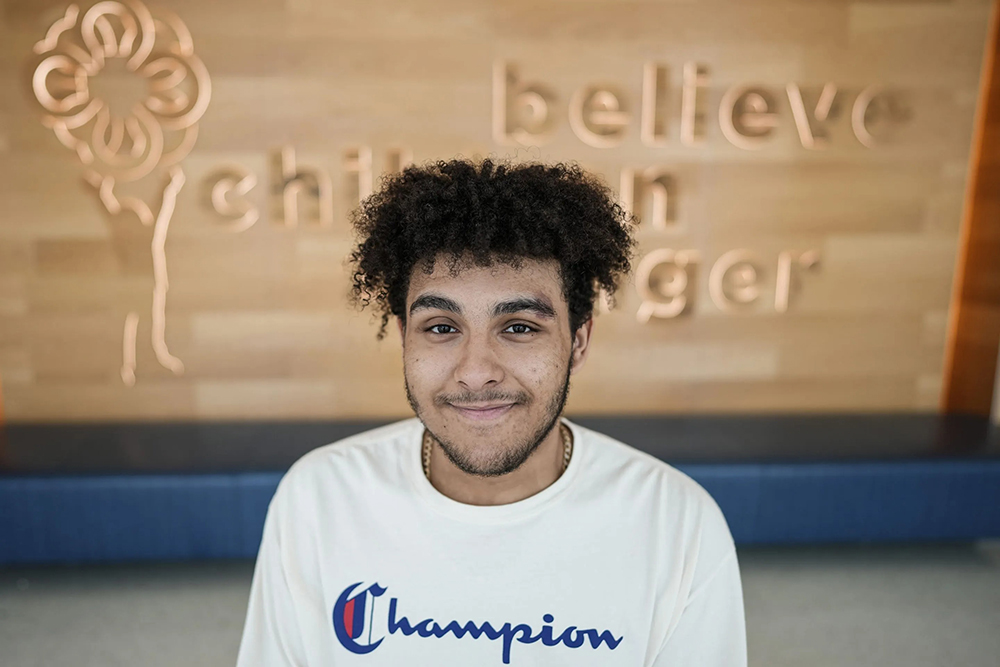 、2024年5月21日,星期二,伊斯雷尔•麦肯齐在田纳西州查塔努加。图片来源:AP PHOTO/MIKE STEWART
、2024年5月21日,星期二,伊斯雷尔•麦肯齐在田纳西州查塔努加。图片来源:AP PHOTO/MIKE STEWART17岁时,伊斯雷尔•麦肯齐饱受肥胖之苦,他高中就辍学了。后来他去餐馆打工,但他不好意思和别人说话。
“我当时的心情很糟糕,”麦肯齐说。他身高6英尺1英寸(约182.84厘米),尽管一再努力节食和锻炼,但体重已攀升至335磅(约151.95公斤)。“我已经绝望了。”
新的研究显示,Wegovy是一种用于治疗糖尿病和肥胖症的药物(GLP-1受体激动剂),服用这种药物的青少年和青壮年人数激增,麦肯齐也是其中的一员。去年,这位田纳西州农村少年开始服用这种减肥药,九个月就减掉了110磅(约49.89公斤)。
对2020年至2023年期间近94%美国零售药店的配药记录的最新分析显示,尽管大量老年人争相购买Ozempic和Wegovy等药物,但这类药物在12至25岁人群中的月使用量也在飙升。
本周三发表在《美国医学会杂志》上的这份报告,利用IQVIA处方数据库首次对GLP-1药物在美国该年龄段人群中的使用情况进行了分析。主导这项研究的密歇根大学儿科医生、糖尿病专家乔伊斯•李博士说,仅在2023年,就有近3.1万名12至17岁的青少年和超过16.2万名18至25岁的青年使用了这种药物。
她说:“这说明,这种药物已经被当作一种减肥药,越来越多的医生会给人们开这种药物。”
报告显示,使用任何GLP-1药物(包括2005年首次获批用于治疗糖尿病和2014年获批用于减肥的老药)的12至25岁年龄段人数,从2020年的每月约8,700人,攀升至2023年的每月6万多人,增幅近600%。尽管这些患者的其他药物处方量下降了约3%,但GLP-1药物的处方量仍出现了上升。
李指出,服用减肥药的人仅占肥胖症年轻人的一小部分。根据美国疾病控制与预防中心的数据,约20%的美国儿童和青少年以及约42%的成人患有这种慢性疾病。
2023年初,美国儿科学会建议对患有肥胖症的儿童和青少年进行早期评估和积极治疗,包括在必要时进行手术和药物治疗。
田纳西州青少年麦肯齐说,他从五年前开始发胖,当时正值青春期。
他说:“我开始通过控制饮食来解决所有问题。”
他的医生说,肥胖使他的哮喘加重,而且他有可能患上糖尿病。他开始遵照医嘱减少含糖汽水和零食的摄入量,并加强锻炼,但这些努力都无济于事。
“我以前的医生告诉我,他无能为力,”他说。“他告诉我,这是我的错。”
2023年初,麦肯齐联系上了田纳西州查塔努加厄兰格儿童医院的儿科肥胖症专家乔尼·杰克医生,他经常给孩子们开GLP-1药物。
杰克说:“我告诉他,我今天已经见过10个和你一样的人,我们有很多治疗方法。”这些方法通常包括密集行为干预和营养干预,必要时结合药物治疗。
针对麦肯齐的情况,杰克给他开了减肥药Wegovy。2022年底,该药获准供美国12岁以上儿童使用。新数据显示,2023年,超过6,000名12岁以上儿童服用Wegovy。超过7,600名12岁以上儿童服用Ozempic,该药最初获准用于治疗成人糖尿病,但可在标签外用于青少年。还有一些人服用一些GLP-1老药,如Saxenda和Trulicity。
麦肯齐说,他并没有出现明显的药物副作用。但李指出,有些年轻人会出现恶心、呕吐或便秘、甚至是严重到需要停药的症状。
李说,了解这类药物在年轻人中的激增使用情况很重要。她说:这类药物需要持续使用,因此“我们确实需要考虑这类药物对年轻人群的长期安全性和有效性。”
此外,这类药物价格昂贵,而且由于供应问题或不在保险范围内,这类药物往往很难获得。
值得注意的是,研究发现,政府管理的医疗补助计划支付了12至17岁青少年近一半以及18至25岁青年约四分之一的GLP-1药物治疗费用。商业保险支付了年龄较小儿童近44%以及年龄较大儿童约三分之二的GLP-1药物治疗费用。
如今,麦肯齐说他的哮喘好多了,他也愿意与同事们和朋友们互动了。
“我现在很自信,比以前自信多了,”他说。“一切都和以前不一样了。”(财富中文网)
美联社健康与科学部得到了霍华德•休斯医学研究所科学与教育媒体集团的支持。美联社对所有内容负全部责任。
翻译:郝秀
审校:汪皓
17岁时,伊斯雷尔•麦肯齐饱受肥胖之苦,他高中就辍学了。后来他去餐馆打工,但他不好意思和别人说话。
“我当时的心情很糟糕,”麦肯齐说。他身高6英尺1英寸(约182.84厘米),尽管一再努力节食和锻炼,但体重已攀升至335磅(约151.95公斤)。“我已经绝望了。”
新的研究显示,Wegovy是一种用于治疗糖尿病和肥胖症的药物(GLP-1受体激动剂),服用这种药物的青少年和青壮年人数激增,麦肯齐也是其中的一员。去年,这位田纳西州农村少年开始服用这种减肥药,九个月就减掉了110磅(约49.89公斤)。
对2020年至2023年期间近94%美国零售药店的配药记录的最新分析显示,尽管大量老年人争相购买Ozempic和Wegovy等药物,但这类药物在12至25岁人群中的月使用量也在飙升。
本周三发表在《美国医学会杂志》上的这份报告,利用IQVIA处方数据库首次对GLP-1药物在美国该年龄段人群中的使用情况进行了分析。主导这项研究的密歇根大学儿科医生、糖尿病专家乔伊斯•李博士说,仅在2023年,就有近3.1万名12至17岁的青少年和超过16.2万名18至25岁的青年使用了这种药物。
她说:“这说明,这种药物已经被当作一种减肥药,越来越多的医生会给人们开这种药物。”
报告显示,使用任何GLP-1药物(包括2005年首次获批用于治疗糖尿病和2014年获批用于减肥的老药)的12至25岁年龄段人数,从2020年的每月约8,700人,攀升至2023年的每月6万多人,增幅近600%。尽管这些患者的其他药物处方量下降了约3%,但GLP-1药物的处方量仍出现了上升。
李指出,服用减肥药的人仅占肥胖症年轻人的一小部分。根据美国疾病控制与预防中心的数据,约20%的美国儿童和青少年以及约42%的成人患有这种慢性疾病。
2023年初,美国儿科学会建议对患有肥胖症的儿童和青少年进行早期评估和积极治疗,包括在必要时进行手术和药物治疗。
田纳西州青少年麦肯齐说,他从五年前开始发胖,当时正值青春期。
他说:“我开始通过控制饮食来解决所有问题。”
他的医生说,肥胖使他的哮喘加重,而且他有可能患上糖尿病。他开始遵照医嘱减少含糖汽水和零食的摄入量,并加强锻炼,但这些努力都无济于事。
“我以前的医生告诉我,他无能为力,”他说。“他告诉我,这是我的错。”
2023年初,麦肯齐联系上了田纳西州查塔努加厄兰格儿童医院的儿科肥胖症专家乔尼·杰克医生,他经常给孩子们开GLP-1药物。
杰克说:“我告诉他,我今天已经见过10个和你一样的人,我们有很多治疗方法。”这些方法通常包括密集行为干预和营养干预,必要时结合药物治疗。
针对麦肯齐的情况,杰克给他开了减肥药Wegovy。2022年底,该药获准供美国12岁以上儿童使用。新数据显示,2023年,超过6,000名12岁以上儿童服用Wegovy。超过7,600名12岁以上儿童服用Ozempic,该药最初获准用于治疗成人糖尿病,但可在标签外用于青少年。还有一些人服用一些GLP-1老药,如Saxenda和Trulicity。
麦肯齐说,他并没有出现明显的药物副作用。但李指出,有些年轻人会出现恶心、呕吐或便秘、甚至是严重到需要停药的症状。
李说,了解这类药物在年轻人中的激增使用情况很重要。她说:这类药物需要持续使用,因此“我们确实需要考虑这类药物对年轻人群的长期安全性和有效性。”
此外,这类药物价格昂贵,而且由于供应问题或不在保险范围内,这类药物往往很难获得。
值得注意的是,研究发现,政府管理的医疗补助计划支付了12至17岁青少年近一半以及18至25岁青年约四分之一的GLP-1药物治疗费用。商业保险支付了年龄较小儿童近44%以及年龄较大儿童约三分之二的GLP-1药物治疗费用。
如今,麦肯齐说他的哮喘好多了,他也愿意与同事们和朋友们互动了。
“我现在很自信,比以前自信多了,”他说。“一切都和以前不一样了。”(财富中文网)
美联社健康与科学部得到了霍华德•休斯医学研究所科学与教育媒体集团的支持。美联社对所有内容负全部责任。
翻译:郝秀
审校:汪皓
At 17, Israel McKenzie was so burdened by obesity that he stopped going to high school in person and was embarrassed to speak to people at his restaurant job.
“I was in a really dark place,” says McKenzie, whose weight had climbed to 335 pounds on his 6-foot-1 frame, despite repeated efforts to diet and exercise. “I had given up hope.”
But last year, the weight-loss drug Wegovy helped him shed 110 pounds in nine months, making the rural Tennessee teen part of a surge of adolescents and young adults using diabetes and obesity medications known as GLP-1 receptor agonists, new research shows.
Even as millions of older adults clamor for drugs such as Ozempic and Wegovy, monthly use of the medications soared in people aged 12 to 25. That’s according to the new analysis of dispensing records from nearly 94% of U.S. retail pharmacies from 2020 to 2023.
The report, published in the journal JAMA on Wednesday, used the IQVIA prescription database to compile the first look at the national uptake of GLP-1 drugs among that age group. Nearly 31,000 children aged 12 to 17 and more than 162,000 people aged 18 to 25 used the medications in 2023 alone, said Dr. Joyce Lee, a University of Michigan pediatrician and diabetes expert who led the research.
“What it’s suggesting is that it’s one of the tools in the toolbox and there are more providers prescribing this medication for the population,” she said.
The report shows that the number of 12- to 25-year-olds using any GLP-1 drug — including older medications first approved to treat diabetes in 2005 and for weight loss in 2014 — climbed from about 8,700 a month in 2020 to more than 60,000 a month in 2023, a nearly 600% increase. The rise occurred even as prescriptions of other drugs among those patients fell by about 3%.
Those who received the drugs were just a fraction of young people who struggle with obesity, Lee noted. About 20% of U.S. children and adolescents and about 42% of adults have the chronic disease, according to the U.S. Centers for Disease Control and Prevention.
In early 2023, the American Academy of Pediatrics recommended that children and teens with obesity be evaluated early and treated aggressively, including with surgery and medication if warranted.
McKenzie, the Tennessee teen, said he began gaining weight five years ago, during puberty.
“I started turning to food for all of my problems,” he said.
The extra weight made his asthma worse and put him in danger of developing diabetes, his doctor said. He tried to follow medical advice by cutting out sugary soda and snack foods and exercising more, but the efforts failed to make a difference.
“My old doctor told me there was nothing he could do,” he said. “He told me it was my fault.”
In early 2023, McKenzie connected with Dr. Joani Jack, a pediatric obesity specialist at Children’s Hospital at Erlanger in Chattanooga, Tennessee, who regularly prescribes GLP-1 drugs for kids.
“I told him I’ve seen 10 other people just like you today and we have lots of tools and treatment options,” Jack said. Those typically include intensive behavioral and nutrition interventions combined with medication, if necessary.
In McKenzie’s case, Jack prescribed the weight-loss drug Wegovy, which in late 2022 was approved for use in U.S. children over age 12. More than 6,000 kids in that age group received Wegovy in 2023, the new data show. More than 7,600 received Ozempic, which is approved to treat diabetes in adults, but can be used off-label in adolescents. Others received older GLP-1 drugs such as Saxenda and Trulicity.
McKenzie said he had no notable side effects from the medication, but Lee noted that some young people report nausea, vomiting or constipation, including symptoms so serious that they stop the drugs.
It’s important to understand the surging use of these medications in young people, Lee said. The drugs are meant for continuing use, so “we really need to think about the long-term safety and effectiveness of these medications for this population,” she said.
In addition, the drugs are expensive and often difficult to obtain, either because of supply problems or because they’re not covered by insurance.
Notably, government-run Medicaid plans paid for nearly half of the GLP-1 drugs prescribed to 12- to 17-year-olds and about a quarter of those used by people aged 18 to 25, the research found. Commercial insurance covered care for nearly 44% of the younger kids and about two-thirds of those who were older.
Today, McKenzie says his asthma is better and he looks forward to interacting with co-workers and friends.
“I have a lot of self-confidence now, a lot more than I used to,” he said. “It has changed everything.”
___
The Associated Press Health and Science Department receives support from the Howard Hughes Medical Institute’s Science and Educational Media Group. The AP is solely responsible for all content.






